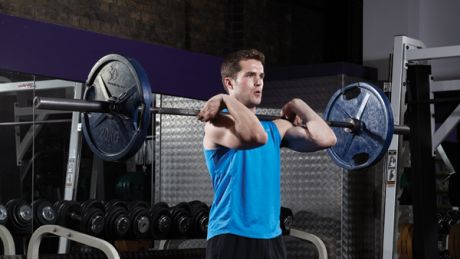How To Perform Perfect Reps
Get the most out of every rep and reap the rewards to become bigger and stronger, says Charles Poliquin.

A lot of guys think that lifting weights is just about moving a bar from point A to point B and back to point A again. A lot of guys are wrong.
You need every rep to be perfect if you want to build lean, hard muscle. You need to work the right muscles for the right amount of time to elicit the best growth response. What’s the point of banging through all your reps as quickly as possible, using momentum to get the weight up but then not controlling it back down? The best-case scenario is zero muscle gains; the worst is serious injury.
So bear these key considerations in mind at the start of every set to and you’ll get the most out of every single rep to make your muscle-mass mission as effective as possible.
Master The Move
Think this is obvious? You’d be amazed how often my jaw hits the floor when I walk into gyms and witness some of the shocking technique on display. Your results are directly proportionate to the extent you understand perfect technique. Mastering the correct movement pattern ensures you work the target muscle to its full potential while minimising injury risk.
Start smart
Many people start a rep in the wrong position, making it impossible to perform it with good form. For example, the correct start position in the front squat (see picture) requires your elbows to be rotated up high, the bar to be slightly choking you, your torso as upright as possible, and your feet shoulder-width apart and slightly externally rotated. If you are not in that position, you have already wasted the rep. Think I’m being too picky? I’m not. Starting with the elbows too low will put enormous strain on the shoulder muscles and spine.
Feel your muscles
Instead of focusing on the external (the weight you’re lifting), focus on the internal (the muscles that are moving it). For example, for incline biceps curls pretend your mind is inside your elbow flexors. Focus on the force of the contraction during the concentric (lifting) range, and on the stretch of the eccentric (lowering) range. Fire your antagonistic muscles (the triceps in this case) as you hit the bottom range. This will stretch your elbow flexors more and augment the force of the next concentric rep. To start with, it’s easier to apply this to single-joint moves than to compound exercises such as squats, which involve more muscle groups.
Hit the right speed
Lifting the weights as quickly as you can will stimulate the parts of the muscle that respond best for growth, and it’s particularly important to focus on this as the set advances and each rep becomes increasingly hard. Research shows that concentrating on the speed of the concentric contraction improves strength development. And it’s just as vital to control the eccentric phase of each rep. The slower you can lower the load, the harder your muscles must work. It’s this part of each rep that leads to greater muscle mass development.
Sign up for workout ideas, training advice, reviews of the latest gear and more.
Count down the reps
Begin every set with a definite goal for the number of reps you want to perform. As you begin your set, count the repetitions down or have your partner count them down. Why? It keeps your mind focused on the task at hand, not on the outcome. When trainees count upwards, they tend to let their mind wander with anxiety on whether they will complete the set or not. It’s a simple mind trick, but it works.
End as you began
The first and the last rep should look the same technically. In the effort to handle progressively heavier loads, there is a temptation to use the heaviest weight possible without regard for technique. Classic technical errors include using excessive momentum to lift the weight, deviating from the correct movement pattern and shortening the range of motion. Keep in mind that the actual training load – the one that determines the result – is determined both by the weight you are using and how you are using it.
Don’t cheat
When you reach muscular failure, you are done for the set. The use of cheating movements to get more repetitions is counterproductive. It teaches bad motor patterns and interferes with the recovery of the motor units (functional units of nerve and muscle) that were trained properly until that point in the set.
One of the world's premier strength coaches, Charles Poliquin has successfully trained professional athletes and Olympians worldwide. Poliquin writes a monthly column for Men's Fitness about how to train as effectively as possible.

